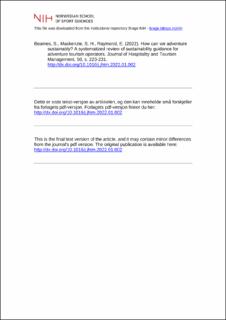| dc.contributor.author | Beames, Simon | |
| dc.contributor.author | Mackenzie, Susan Houge | |
| dc.contributor.author | Raymond, Eliza | |
| dc.date.accessioned | 2024-03-01T12:24:05Z | |
| dc.date.available | 2024-03-01T12:24:05Z | |
| dc.date.created | 2022-05-02T13:28:21Z | |
| dc.date.issued | 2022 | |
| dc.identifier.citation | Journal of Hospitality and Tourism Management. 2022, 50, 223-231. | en_US |
| dc.identifier.issn | 1447-6770 | |
| dc.identifier.uri | https://hdl.handle.net/11250/3120669 | |
| dc.description | I Brage finner du siste tekst-versjon av artikkelen, og den kan inneholde ubetydelige forskjeller fra forlagets pdf-versjon. Forlagets pdf-versjon finner du på sciencedirect.com / In Brage you'll find the final text version of the article, and it may contain insignificant differences from the journal's pdf version. The definitive version is available at sciencedirect.com | en_US |
| dc.description.abstract | Adventure tourism operators have historically drawn upon a range of broad, multi-purpose sustainability frameworks to provide experiences that are more ecologically and socially just. However, these efforts have been hindered by the need to interpret and translate large volumes of diverse sustainability guidance, which is often unclear or prohibitively complex in terms of how it can be applied to specific adventure operations. This paper aims to address this issue by (1) identifying the primary types of sustainability guidance available for adventure operators; (2) critiquing the benefits and limitations of each form of guidance; and (3) making recommendations for research and practice. The inquiry employed a systematized review methodology, informed by Preferred Reporting Items for Systematic Reviews and Meta-Analyses (PRISMA) guidelines, to interrogate the various forms of sustainability guidance available to adventure tour operators. The analysis revealed three broad categories of guidance: Paid Memberships and Certifications, Guidelines and Frameworks, and Pledges and Declarations. The findings demonstrate how each of these categories brings distinct benefits and limitations to operators, depending on their size and scope of provision. Implications for practice are offered, in terms of how existing frameworks might be adopted and/or alternative approaches to integrating and monitoring sustainability initiatives developed. Suggestions for further research include examining adventure travellers' and operators' perceptions of the three different categories of guidance found in the current study, and the ways in which operators engage with this guidance. | en_US |
| dc.language.iso | eng | en_US |
| dc.subject | adventure tourism | en_US |
| dc.subject | sustainability | en_US |
| dc.subject | guidance | en_US |
| dc.subject | certification | en_US |
| dc.subject | systematized review | en_US |
| dc.title | How can we adventure sustainably?: A systematized review of sustainability guidance for adventure tourism operators | en_US |
| dc.title.alternative | How can we adventure sustainably? A systematized review of sustainability guidance for adventure tourism operators | en_US |
| dc.type | Peer reviewed | en_US |
| dc.type | Journal article | en_US |
| dc.description.version | acceptedVersion | en_US |
| dc.source.pagenumber | 223-231 | en_US |
| dc.source.volume | 50 | en_US |
| dc.source.journal | Journal of Hospitality and Tourism Management | en_US |
| dc.identifier.doi | 10.1016/j.jhtm.2022.01.002 | |
| dc.identifier.cristin | 2020684 | |
| dc.description.localcode | Institutt for lærerutdanning og friluftslivsstudier / Department of Teacher Education and Outdoor Studies | en_US |
| cristin.ispublished | true | |
| cristin.fulltext | postprint | |
| cristin.qualitycode | 1 | |
